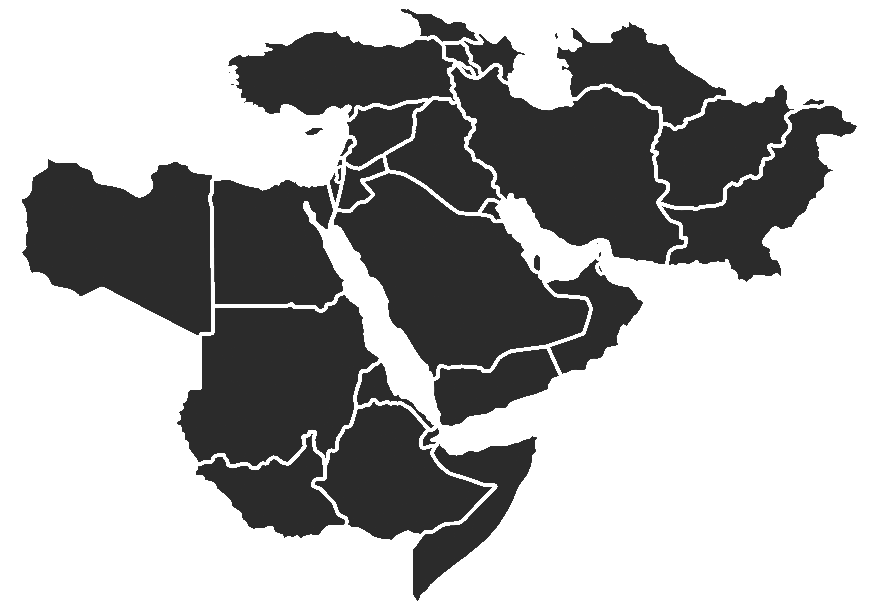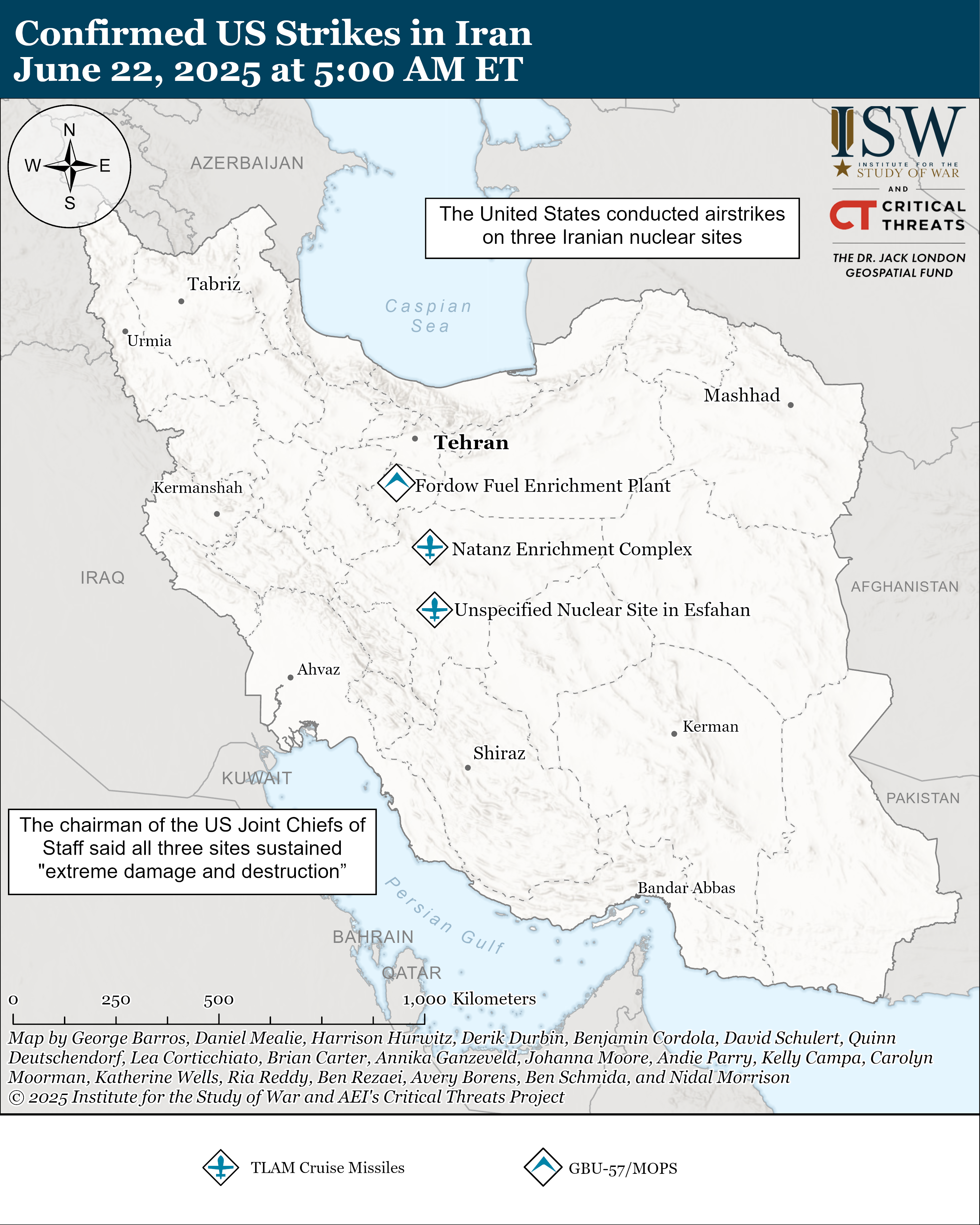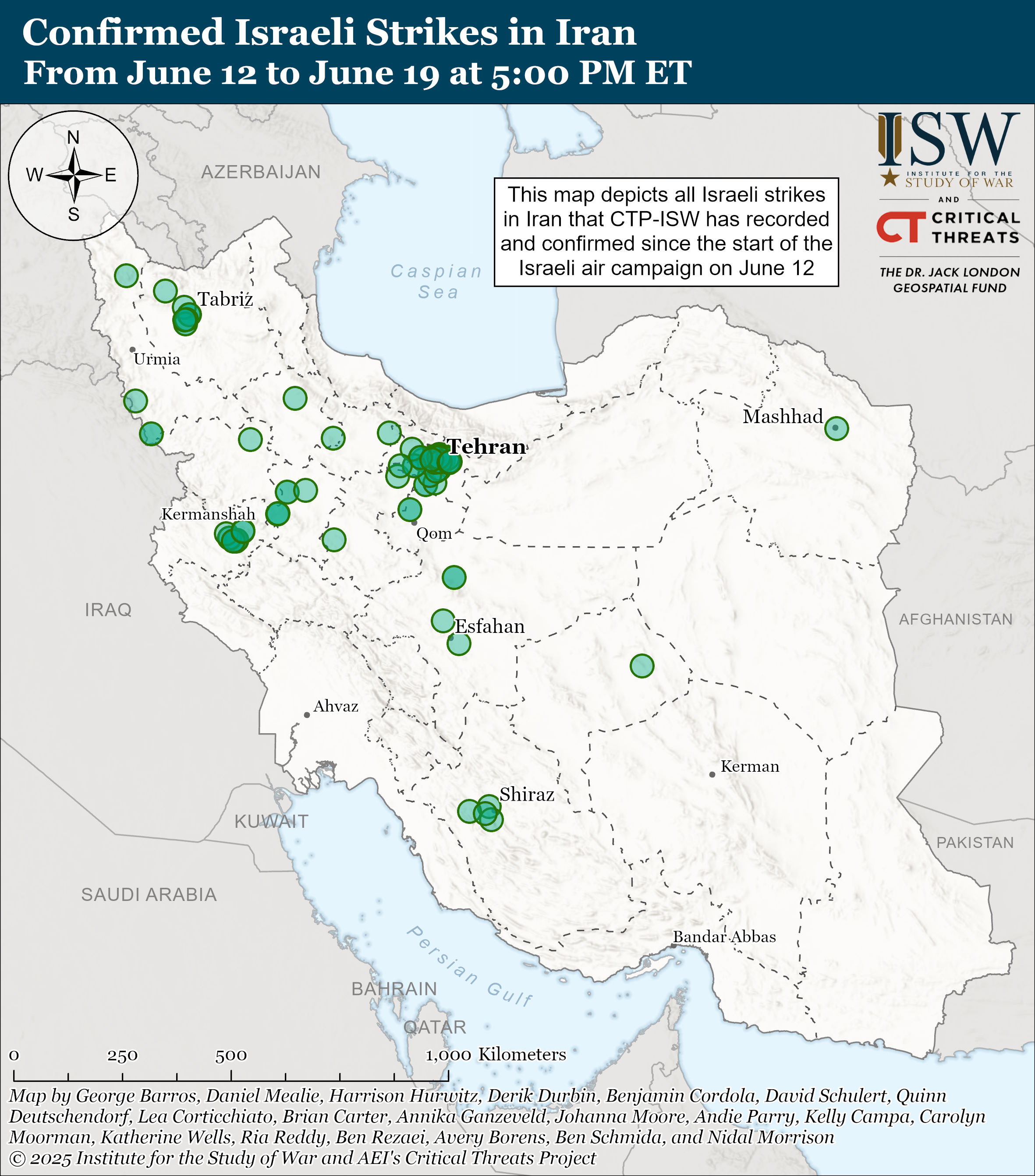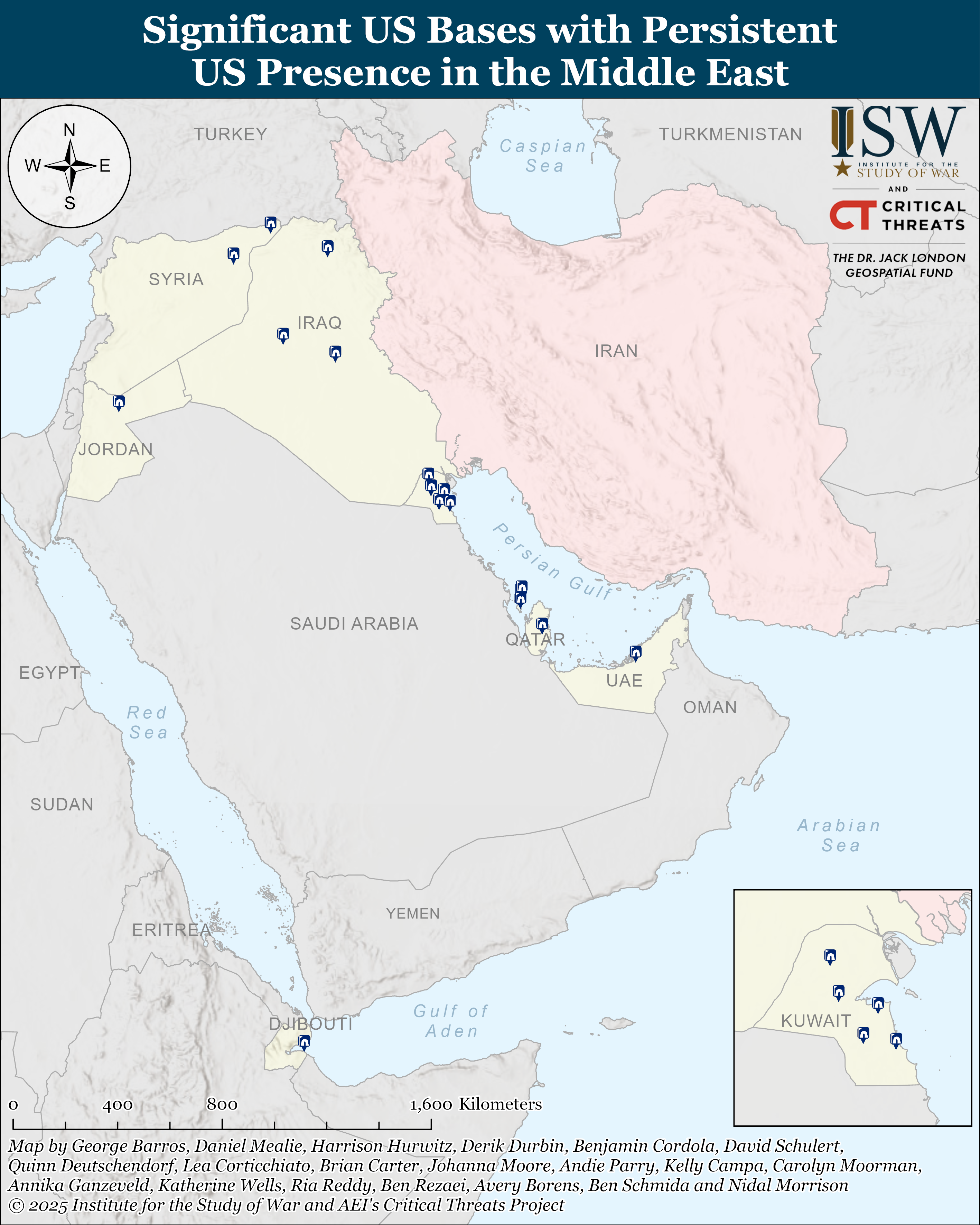{{currentView.title}}
June 23, 2025
Iranian Calculus and Response Options following the US strikes
NOTE: CTP-ISW is tracking early reports of Iranian missile attacks on US forces in Qatar and Iraq at the time of this publication. CTP-ISW will cover these events in our twice daily Iran Updates found here.
Iranian leaders are currently calibrating their response to the United States striking their nuclear program. How they ultimately respond will depend on what they conclude is necessary to preserve the Islamic Republic and ensure its longevity. That conclusion will, in turn, derive from how Iranian leaders understand their current situation and their risk tolerance. The following is an assessment that examines these factors and what key decisions Tehran is facing and how it will likely proceed.
Context
The United States struck and severely damaged three Iranian nuclear sites on June 21, using Massive Ordnance Penetrator bunker busters and Tomahawk cruise missiles.[i] The United States targeted the two primary Iranian enrichment facilities at Natanz and Fordow as well as a third site that stored processed uranium.[ii] The US strikes likely destroyed a considerable portion of the Iranian enriched uranium stockpile and cascades of centrifuges. Though Iran appears to have moved some of its nuclear material and equipment to other undisclosed sites beforehand, the US strikes have likely disrupted the Iranian nuclear program considerably.[iii] The US strikes came as Israel has conducted its own strike campaign into Iran, targeting the nuclear program, military and security sites, energy infrastructure, and key leaders. The US and Israeli efforts combined amount to the most serious blow to the Islamic Republic since its war against Saddam Hussein’s Iraq in the 1980s.
Senior Iranian officials have responded by vowing retaliation against the United States. Unspecified US officials have said that Iran could attack US forces in the Middle East in the coming days, while others have suggested that an attack could be imminent.[iv]
Iranian Considerations
Iranian leaders have limited options in responding to the United States. They could, of course, grant concessions on their nuclear program as well as possibly on their missile capabilities and extraterritorial activities, as the United States has demanded. But Iranian Supreme Leader Ali Khamenei would likely consider such concessions to be tantamount to surrender and another step toward the weakening of his regime. Khamenei has long relied on the Iranian nuclear program, missile arsenal, and so-called “Axis of Resistance” as his chief means of projecting power and threatening adversaries. Compromising on these fundamental tenets of Iranian strategy would substantially erode Iranian military power. Khamenei may be especially averse to such concessions now, while his regime faces the unprecedented challenge of simultaneous US and Israeli strikes. Some Iranian officials appear amenable to compromise with the United States, given that the nuclear program, missiles, and proxy and partner forces have demonstrably failed to deter attacks on Iran.[v] But Khamenei himself has shown no sign of considering such concessions at this time. Khamenei may instead therefore calculate that the best approach to preserving his regime, which is his foremost priority, is continuing to fight and resist.
This assessment assumes that Khamenei will maintain his past calculus and decision-making tendencies. Khamenei faces an unprecedented circumstance, however, which could lead him to break from his past patterns of behavior. If Khamenei concludes that the Iranian nuclear program, missile arsenal, and Axis of Resistance are no longer critical to regime survival, he may acquiesce to US demands.
Assuming Khamenei decides to continue fighting, he will likely base his ultimate decision given several factors in mind. These factors include:
- His desire to avoid further escalation with the United States. Khamenei seeks to rebuild deterrence vis-à-vis the United States and Israel but without inviting further escalation. Khamenei therefore needs to balance between using sufficient force to deter while also avoiding any attack that drives the United States and Israel to hit back harder. Striking this balance will be extremely difficult—if not impossible.
- The disruption to the military command. Khamenei will need to calibrate his response without the key generals on whom he has relied for decades for advice. The Israeli killing of senior Iranian military officers deprives Khamenei of these trusted subordinates and induces temporary disruption to the chain of command.[vi] Khamenei will likely face friction here, as he lacks the same personal rapport with the new cadre of commanders.
- The precarious domestic situation. Khamenei is considering a major military undertaking against the United States, while his regime is increasingly unstable domestically. Israeli strikes have targeted Iranian energy infrastructure and sites tied to domestic surveillance and social control.[vii] These strikes have caused severe economic disruption and degraded the regime ability to repress its increasingly restive population.
- The overall degradation of Iranian Capabilities. Iran has lost many of its levers of power over the past 19 months. The Axis of Resistance is ill-positioned to fight a large-scale war against the United States, as it is exhausted from many months of fighting Israel.[viii] Israeli strikes have, moreover, degraded Iranian air defenses and missile capabilities, making the regime more vulnerable than it has been in years to conventional attack.[ix]
Key Decisions
Khamenei will face two key decisions as he contemplates how to respond to the United States. He must decide firstly how to retaliate (i.e., through what means). Khamenei has four real response options in this context.
- Missile and drone strikes. Iran could fire a large volume of missiles and drones at US forces in the Middle East. Iranian missile forces are badly degraded, as already noted, as Israel has destroyed a significant number of the Iranian missile launchers.[x] But Iran still has enough capacity to summon a large volley of projectiles targeting US forces, especially in Iraq and around the Arabian Peninsula.[xi]
- Militia attacks. Iran could order its proxy and partner militias to attack US forces across the region. Iran would likely look to its Iraqi militias to threaten US bases in Iraq and Syria and look to the Houthis to threaten US naval assets around the Red Sea and Gulf of Aden. These groups have previously performed these roles in support of Iranian objectives.[xii] Iran has equipped both parties with advanced strike capabilities, such as missiles and drones, that they could use to target US forces.[xiii]
- Naval aggression. Iranian naval forces have emerged largely unscathed from the war with Israel. Iranian officials have openly threatened to “close the Strait of Hormuz” in recent days, which in practice would likely involve using naval assets and coastal systems to attack international shipping.[xiv] The Iranian Artesh and IRGC have prioritized developing their force projection capabilities in recent years in order to threaten commerce further abroad.[xv]
- Terror operations. Iran and Hezbollah have spent years developing a network of covert cells abroad, possibly including in some Western and Latin American countries. Iranian officials have threatened explicitly to activate these cells to conduct terror attacks in the United States in retaliation for the US strikes.[xvi] There is precedent for Iran trying to use covert cells to conduct terror attacks on US soil.[xvii]
Khamenei must separately decide how much risk he is prepared to accept. Any attack against US interests and personnel will risk escalating the war further, regardless of how much force is used. Khamenei can mitigate that risk by opting for a less dramatic attack. He can alternatively decide to impose a high cost on the United States, which would carry a very high risk of escalation. Regardless of what decision he makes, any attack on US interests and personnel carries the risk of imposing serious losses, which Khamenei would accept beforehand.
Conclusion
The most likely Iranian response at this time is a tempered missile or militia attack on US forces in the Middle East. The most dangerous Iranian response would include a combination of the four options described above and seek to impose a serious cost on the United States. Even a tempered missile or militia attack would risk US casualties, which should be unacceptable for Washington. Regardless of which path Khamenei chooses, the United States must be prepared to defend its interests and personnel and take appropriate actions to deter Iranian attacks on the American people and homeland.
[i] https://www.bbc.com/news/articles/cvg9r4q99g4o
[ii] https://www.reuters.com/world/middle-east/iaea-says-entrances-tunnels-irans-isfahan-site-hit-by-us-strike-2025-06-22/
[iii] https://nypost.com/2025/06/23/world-news/satellite-images-show-trucks-lined-up-at-irans-fordo-nuclear-facility-before-us-air-strikes/
[iv] https://www.reuters.com/world/middle-east/iranian-retaliation-against-us-forces-could-come-soon-us-officials-say-2025-06-23/ ; https://amwaj.media/en/media-monitor/exclusive-iranian-retaliation-against-us-forces-most-probably-hours-away
[v] https://www.theatlantic.com/international/archive/2025/06/inside-plot-push-khamenei-aside/683286/
[vi] https://time.com/7293886/iranian-generals-scientists-targets-killed-by-israeli-strikes/
[vii] https://www.nytimes.com/interactive/2025/06/18/world/middleeast/israel-iran-strikes-facilities-map.html ; https://www.wsj.com/livecoverage/israel-iran-attack-news/card/iran-s-revolutionary-guard-confirms-israel-killed-its-intelligence-chief-TyadaKWHo9IU3GPtFC1A?gaa_at=eafs&gaa_n=ASWzDAjghoFgco2hSNDK8aEfRAZUQHmwGqp9atgP5KttysE2glrZSdIJVTJ6I7grFhY%3D&gaa_ts=6859854d&gaa_sig=4XOguJMzmkYBqn95E6PrsD2pYce71BMdRt4_DtTzA3C2zafaYzo_p7eK27kAkXrtYf8crXrtZ8PLaNwJ5E8rDQ%3D%3D
[viii] https://www.criticalthreats.org/analysis/the-deafening-silence-of-irans-proxies
[ix] https://www.axios.com/2025/06/22/trump-israel-iran-strikes-air-defenses ; https://www.nytimes.com/2025/06/22/us/politics/iran-weapons-us-bases.html
[x] https://www.jns.org/israel-destroys-iranian-missile-launchers-used-in-morning-attack/
[xi] https://www.iiss.org/online-analysis/online-analysis/2025/06/israels-attack-and-the-limits-of-irans-missile-strategy/
[xii] https://www.understandingwar.org/backgrounder/cost-inaction-yemen; https://understandingwar.org/backgrounder/iran-update-october-25-2023; https://www.aei.org/research-products/report/pivot-to-offense-how-iran-is-adapting-for-modern-conflict-and-warfare/
[xiii] https://www.aei.org/research-products/report/pivot-to-offense-how-iran-is-adapting-for-modern-conflict-and-warfare/; https://www.aei.org/research-products/report/yemens-houthis-and-the-expansion-of-irans-axis-of-resistance/
[xiv] https://www.cnbc.com/2025/06/23/irans-parliament-approves-blocking-strait-of-hormuz.html
[xv] https://www.aei.org/research-products/report/pivot-to-offense-how-iran-is-adapting-for-modern-conflict-and-warfare/
[xvi] https://www.nbcnews.com/nightly-news/video/u-s-officials-iran-threatened-terror-attacks-inside-u-s-242058821681
[xvii] https://www.aipac.org/resources/26-years-since-amia-bombing-3zjsy-xzces-c9peh




